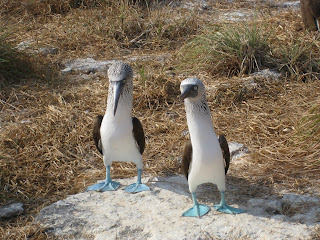The afternoon departure was delayed until the dredging crew
dropped the cable which ran across the narrow harbor channel. We progressed
slowly toward the dredge and as we approached the workers signaled us forward.
The cable which was strung tight was dropped; we motored thru and were on our
way south. Winds remained light at 10 – 19 kts until midnight . We decided to motor as the breeze of 3-5 kts
was not helping to keep the sail full on the downwind. The rest of the night
was uneventful without any traffic until we reached the northern end of Isla
Isabel. There were a lot of pangas and fish trawlers working the area. Since
snagging a long line inbound to Mazatlan
The island offers two small anchorages, neither one
completely protected. We motored around to evaluate both options and decided to
drop the hook on the south side of the island. Our friends on S/V Zoe arrived
soon after. Paul and I napped to recover from a short but tiring overnight
passage. Paul decided to go ashore mid afternoon to explore the rookeries. I
stayed with the boat as I was a little nervous to leave due to the anchorage.
The island is a world famous rookery for the blue footed
boobies and the frigates. It is very similar to Heron
Island
On day two we both went ashore and hiked to the ridge to see
the birds. The photos will not do it justice. The birds were everywhere. We
hiked off the ridge and went to explore the caldera lake center island. We met
some researchers who told us about the other rookery. We ended up hiking out to
their research station. The whole morning was really great.
Back on the boat we took a swim to
cool off and hunkered down inside to avoid the humidity. The inside cabin salon
stays cool with a good breeze blowing thru. Water temps are upper 70s (I wish
they were a little warmer…) and the humidity feels like 80 – 90% (Probably not,
but it feels like it). Tomorrow we are planning to depart early and sail to Chacala.
It will be about a 55 nm passage.
 |
| There is a small fishing village where you land the dinghy. Notice all the flying birds, I think mostly frigates. |
 |
| The frigates nest in the trees. They are every where and you have to be careful as you walk around that your not a target. |
 |
| Paul on the hike up to the booby rookery. Note Talos IV in the background just above his left shoulder. |
 |
| Frigates in the tree just above our heads as we walked down the trail. The one with the red is a male. |
 |
| The rookery was full of boobys. |
 |
| Female booby with her egg underneath her. You can just make it out. |
 |
| The iguanas and lizirds had their day as well. You had to watch your step to avoid stepping on one. |
 |
| Janet with las Monas. |
 |
| Tia and birds just don't mix, so she stayed well protected under the dodger during our stay at Isla Isabela. |



No comments:
Post a Comment